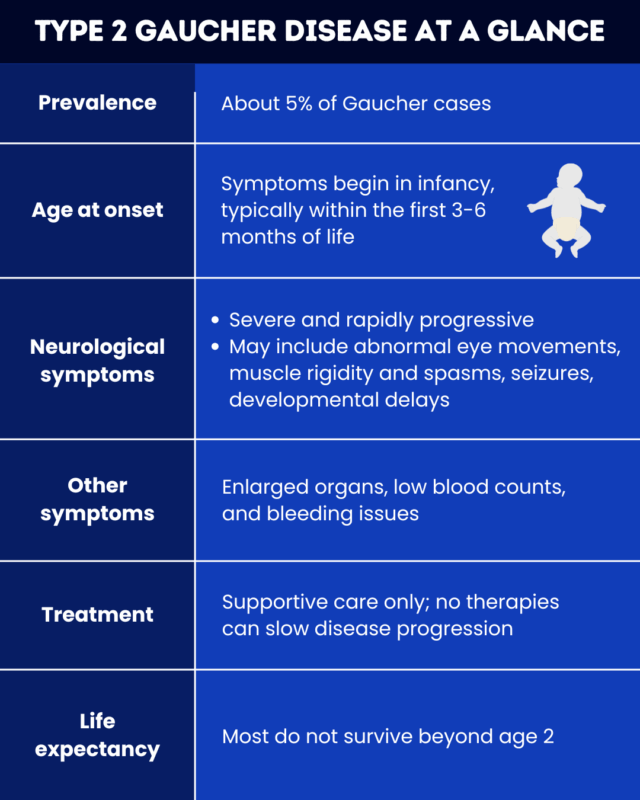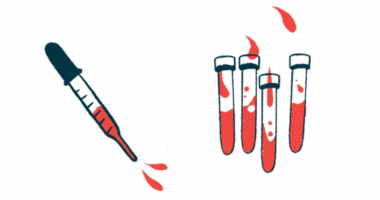
Gaucher disease type 2: What to know
Last updated July 22, 2025, by Marisa Wexler, MS

Gaucher disease type 2 is a rare and severe form of early-onset Gaucher disease characterized by rapidly worsening neurological symptoms that manifest in the first months of life.
Also known as acute neuronopathic Gaucher disease or acute infantile Gaucher disease, this type accounts for about 5% of all Gaucher cases.
There are currently no effective treatments available to slow or stop the progression of type 2 Gaucher disease, and most children do not survive beyond age 2. Supportive care is essential to help keep patients comfortable and improve quality of life for both the child and their family.
What causes Gaucher disease type 2?
Gaucher disease is a lysosomal storage disorder caused by mutations in the GBA1 gene. This gene provides instructions for making an enzyme called glucocerebrosidase, which is needed to break down certain fatty molecules inside cells.
In people with Gaucher, glucocerebrosidase is either missing or doesn’t work properly. This glucocerebrosidase deficiency causes fatty substances to accumulate to toxic levels in certain organs and tissues, such as the liver, spleen, and bones.
In Gaucher type 2, this buildup also occurs in the brain and spinal cord, leading to severe neurological symptoms.
Gaucher disease is inherited in an autosomal recessive manner, meaning a child must inherit two faulty gene copies — one from each biological parent — to develop the disease. Carriers, who have only one mutated copy, typically show no symptoms, but can pass the mutation to their children.
More than 400 different GBA1 gene mutations have been linked to Gaucher. While most do not predict which disease type a person will develop, some are more commonly found in certain types. One example is the p.Leu483Pro mutation, which is often linked to types 2 and 3 — though it has also been reported in people with type 1.
Mutations that completely disrupt glucocerebrosidase enzyme activity are commonly associated with a particularly severe form of Gaucher disease type 2, called perinatal lethal Gaucher disease, in which babies die before or within the first days after birth.
How is type 2 different from other types?
Type 2 Gaucher disease stands out from other Gaucher disease types because it causes severe neurological symptoms that begin in early infancy and worsen rapidly.
This is in contrast to type 1, which is defined by a complete absence of neurological symptoms.
Type 3 is also considered a neuronopathic form of Gaucher disease because it affects the nervous system. But neurological symptoms usually appear later in childhood and tend to progress more slowly, with many people with type 3 surviving into adulthood.
Because of its early and aggressive neurological symptoms, Gaucher disease life expectancy in is significantly shorter in type 2 than in other forms, with children rarely surviving beyond early childhood.
Signs and symptoms
Gaucher disease type 2 typically causes symptoms within the first 3 to 6 months of life. These include both neurological symptoms and complications affecting other organs.
Neurological symptoms of type 2 Gaucher may include:
- abnormal eye movements
- muscle rigidity and spasms
- trouble swallowing
- seizures
- poor growth and failure to meet developmental milestones
- trouble breathing.
In addition to neurological issues, other symptoms may include:
- enlarged spleen and liver
- low blood cell counts
- easy bleeding
- severe swelling
- skin problems
- abnormal facial features.
How is type 2 Gaucher disease diagnosed?
All forms of Gaucher disease are diagnosed by testing the activity of the glucocerebrosidase enzyme. This is generally done with a blood test. If enzyme activity is lower than 15% of normal, a diagnosis of Gaucher disease can be confirmed.
In some regions, Gaucher disease diagnosis in babies is possible through newborn screening programs, which measure glucocerebrosidase activity in a blood sample taken shortly after birth. These programs help identify Gaucher disease in infants early, allowing families to seek appropriate care as soon as possible.
Genetic testing for Gaucher is also available to identify mutations in the GBA1 gene. While it is not required to make a diagnosis, it can provide additional confirmation. Genetic testing is also useful for identifying Gaucher carriers and helping prospective parents understand the risk of having a child with the disease.
However, neither enzyme tests nor genetic testing can distinguish between the different types of Gaucher. To confirm a diagnosis of Gaucher disease type 2 , doctors must evaluate a child’s symptoms, especially the presence of early and severe neurological issues.
Brain imaging and neurological assessments may also be used to assess the presence and extent of neurological involvement and help confirm the diagnosis.
Treatment and supportive care
While there are approved treatments for Gaucher, these therapies do not cross into the brain. As a result, they have limited benefits for people with type 2 Gaucher, where neurological symptoms are the most severe feature.
Enzyme replacement therapy (ERT) for Gaucher may sometimes be offered to infants with type 2 to address complications such as enlarged organs or low blood counts, but its use remains controversial. Because ERT is expensive and can be burdensome for families, decisions about whether to pursue it should be made in collaboration with medical teams, with a clear understanding of its limitations.
In the absence of treatments that slow or stop disease progression, care for type 2 Gaucher mainly focuses on supportive strategies to help manage symptoms and maximize comfort. These often include:
- alternative feeding strategies, such as as thickened formula, modified bottles, or feeding tubes
- medications to manage certain symptoms, such as muscle stiffness, digestive problems, and irritability
- blood transfusions to manage low blood counts and bleeding issues
- palliative care to reduce discomfort and support families.
Care is often coordinated by a multidisciplinary team, which may include neurologists, geneticists, palliative specialists, and nutritionists.
Prognosis
Type 2 Gaucher disease prognosis is significantly poorer than that of other disease types. Most affected children do not survive beyond age 2, and average life expectancy is less than one year.
Because of the disease’s severity, early diagnosis is important to help families plan care, access supportive services, and receive guidance from specialists.
There are also many types of support for rare diseases like Gaucher type 2. Patient organizations, such as the National Gaucher Foundation, offer resources, community support, and connection to families facing similar challenges, helping them feel less alone and more supported.
Gaucher Disease News is strictly a news and information website about the disease. It does not provide medical advice, diagnosis, or treatment. This content is not intended to be a substitute for professional medical advice, diagnosis, or treatment. Always seek the advice of your physician or other qualified health provider with any questions you may have regarding a medical condition. Never disregard professional medical advice or delay in seeking it because of something you have read on this website.
Recent Posts
- Bone complications affect most people with Gaucher disease, study finds
- Gaucher treatment doesn’t normalize key biomarker levels
- Constant medical vulnerability can be exhausting
- Understanding genetic factors seen key to personalized therapy
- Researchers uncover seven new genetic variants in Gaucher disease



